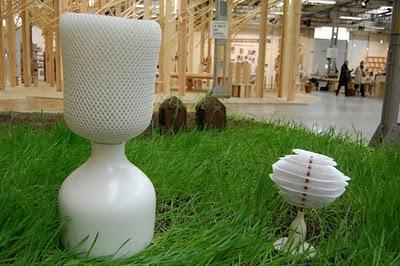

The 'city eco lab' had a couple of possible solutions for the collection of rainwater. one was fréderic ruyuant's prototype which had three long pipes with shower heads at the end of each, extending from a toilet's water tank. ruyant asks, 'rain comes to us from the sky, it waters our soils and fertilizes our land. what about rain water in our urban environments, which disappears into the bowels of the city before flowing back into our rivers?' his protoype acts as a visual metaphor for this situation. 'Ondée' is a rainwater collector made from ceramic and 3D textile by olivier gassies of école boulle, 2007

The ‘Rain Storage’ Bench is a water container that stands outside park and garden. It reduces the amount of raindrop from sky going straight into a gap. Saving water is one of the world’s environmental problems.

WATERFULL is an effective private upper-well that can be integrated in the home environment as a multi -season water collector as well as a shading element. In the reality of global warming and evident lack of water in many areas around the world, WATERFULL creates a self-sufficient platform that enables the home-user to collect dew and rain water for everyday needs. Doing so, one is able to make use of the natural abundance available in his surroundings.

The 'dropnet' by german designer imke hoehler is a fog collector which has the potential to provide drinking water supplies to areas with low infrastructure. Using natural and local resources, the collector filters tiny water droplets from fog clouds causing the droplets to coalesce. The piece has been designed to be built up on flat and uneven ground in situations with or without hillsides. The best conditions for installing the fog collectors are in especially arid, coastal areas with altitudes between 400 m and 1200 m which exhibit a lot of fog accumulation. Such locations include chile, haiti, peru, nepal, spain etc. depending on the conditions, 'dropnet' can collect 10 to 20 liters of water per m2 a day.

All images via designboom.com





